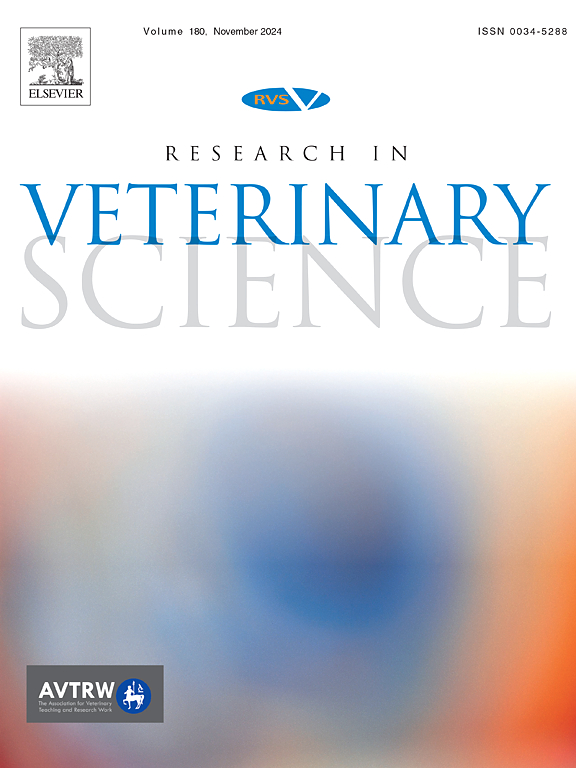Efficacy of transdermal ketoprofen on surgical inflammation in dogs
IF 2.2
3区 农林科学
Q1 VETERINARY SCIENCES
引用次数: 0
Abstract
Ketoprofen is a non-steroidal anti-inflammatory drug (NSAID) used to treat pain and inflammation in dogs. Despite having effective analgesic efficacy, prolonged oral administration has been associated with adverse effects. Transdermal delivery of ketoprofen has reduced the incidence of adverse effects in humans and could potentially be used in veterinary clinical medicine. A transdermal (TD) ketoprofen formulation was recently developed for use in dogs and this study aimed to determine the pharmacodynamic activity of this formulation using surgical castration as an acute inflammatory model. Twelve dogs were randomly assigned to either a Control group (n = 6) or a TD group (n = 6). All dogs were castrated using standard surgical protocols, administered with pre-medication, consisting of acepromazine (0.055 mg/kg) and methadone (0.5 mg/kg) intramuscularly (IM) 30 min prior to induction of general anaesthesia. All dogs were then anaesthetised by injecting alfaxalone (2 mg/kg IV) via a 20 G 3 cm catheter in the left cephalic vein and subsequently maintained using isoflurane. Along with that TD group dogs also received TD ketoprofen (10 mg/kg) 1 h before pre-medication. Bloods were collected at 0 – hour (pre-surgery), and 1 and 2-h post-surgery and analysed for circulating eicosanoids using liquid chromatography mass spectrometry (LCMS) methods. Measured levels of Thromboxane B2 (TXB2) at both 1 and 2 h and Prostaglandin E2 (PGE2) at 2 h post-surgery were higher in the Control group compared to the TD group, suggesting pre-operative application of TD ketoprofen has a possible inhibitory effect on systemic inflammation and could be used to treat pain and inflammation in dogs.
透皮酮洛芬治疗犬外科炎症的疗效。
酮洛芬是一种非甾体抗炎药(NSAID),用于治疗狗的疼痛和炎症。尽管具有有效的镇痛效果,但长期口服已与不良反应有关。经皮给药酮洛芬降低了人类不良反应的发生率,并有可能用于兽医临床医学。最近开发了一种透皮(TD)酮洛芬制剂,用于狗,本研究旨在通过手术阉割作为急性炎症模型确定该制剂的药效学活性。12只狗随机分为对照组(n = 6)和TD组(n = 6)。所有狗都采用标准手术方案阉割,在全身麻醉前30分钟肌肉注射乙酰丙嗪(0.055 mg/kg)和美沙酮(0.5 mg/kg)。所有犬均通过20 G 3 cm的左头静脉导管注射阿法沙龙(2mg /kg IV)麻醉,随后使用异氟烷维持麻醉。与TD组狗一起,在用药前1小时给予TD酮洛芬(10 mg/kg)。术前0小时、术后1小时和2小时采集血液,采用液相色谱-质谱法(LCMS)分析循环类二十烷酸。对照组术后1和2小时血栓素B2 (TXB2)和前列腺素E2 (PGE2)水平均高于TD组,提示术前应用TD酮洛芬可能对全身炎症有抑制作用,可用于治疗犬的疼痛和炎症。
本文章由计算机程序翻译,如有差异,请以英文原文为准。
求助全文
约1分钟内获得全文
求助全文
来源期刊

Research in veterinary science
农林科学-兽医学
CiteScore
4.40
自引率
4.20%
发文量
312
审稿时长
75 days
期刊介绍:
Research in Veterinary Science is an International multi-disciplinary journal publishing original articles, reviews and short communications of a high scientific and ethical standard in all aspects of veterinary and biomedical research.
The primary aim of the journal is to inform veterinary and biomedical scientists of significant advances in veterinary and related research through prompt publication and dissemination. Secondly, the journal aims to provide a general multi-disciplinary forum for discussion and debate of news and issues concerning veterinary science. Thirdly, to promote the dissemination of knowledge to a broader range of professions, globally.
High quality papers on all species of animals are considered, particularly those considered to be of high scientific importance and originality, and with interdisciplinary interest. The journal encourages papers providing results that have clear implications for understanding disease pathogenesis and for the development of control measures or treatments, as well as those dealing with a comparative biomedical approach, which represents a substantial improvement to animal and human health.
Studies without a robust scientific hypothesis or that are preliminary, or of weak originality, as well as negative results, are not appropriate for the journal. Furthermore, observational approaches, case studies or field reports lacking an advancement in general knowledge do not fall within the scope of the journal.
 求助内容:
求助内容: 应助结果提醒方式:
应助结果提醒方式:


